Zhengyu Li
Enhancing Time Series Forecasting through Selective Representation Spaces: A Patch Perspective
Oct 16, 2025Abstract:Time Series Forecasting has made significant progress with the help of Patching technique, which partitions time series into multiple patches to effectively retain contextual semantic information into a representation space beneficial for modeling long-term dependencies. However, conventional patching partitions a time series into adjacent patches, which causes a fixed representation space, thus resulting in insufficiently expressful representations. In this paper, we pioneer the exploration of constructing a selective representation space to flexibly include the most informative patches for forecasting. Specifically, we propose the Selective Representation Space (SRS) module, which utilizes the learnable Selective Patching and Dynamic Reassembly techniques to adaptively select and shuffle the patches from the contextual time series, aiming at fully exploiting the information of contextual time series to enhance the forecasting performance of patch-based models. To demonstrate the effectiveness of SRS module, we propose a simple yet effective SRSNet consisting of SRS and an MLP head, which achieves state-of-the-art performance on real-world datasets from multiple domains. Furthermore, as a novel plugin-and-play module, SRS can also enhance the performance of existing patch-based models. The resources are available at https://github.com/decisionintelligence/SRSNet.
Unlocking the Power of Mixture-of-Experts for Task-Aware Time Series Analytics
Sep 26, 2025Abstract:Time Series Analysis is widely used in various real-world applications such as weather forecasting, financial fraud detection, imputation for missing data in IoT systems, and classification for action recognization. Mixture-of-Experts (MoE), as a powerful architecture, though demonstrating effectiveness in NLP, still falls short in adapting to versatile tasks in time series analytics due to its task-agnostic router and the lack of capability in modeling channel correlations. In this study, we propose a novel, general MoE-based time series framework called PatchMoE to support the intricate ``knowledge'' utilization for distinct tasks, thus task-aware. Based on the observation that hierarchical representations often vary across tasks, e.g., forecasting vs. classification, we propose a Recurrent Noisy Gating to utilize the hierarchical information in routing, thus obtaining task-sepcific capability. And the routing strategy is operated on time series tokens in both temporal and channel dimensions, and encouraged by a meticulously designed Temporal \& Channel Load Balancing Loss to model the intricate temporal and channel correlations. Comprehensive experiments on five downstream tasks demonstrate the state-of-the-art performance of PatchMoE.
DAG: A Dual Causal Network for Time Series Forecasting with Exogenous Variables
Sep 18, 2025Abstract:Time series forecasting is crucial in various fields such as economics, traffic, and AIOps. However, in real-world applications, focusing solely on the endogenous variables (i.e., target variables), is often insufficient to ensure accurate predictions. Considering exogenous variables (i.e., covariates) provides additional predictive information, thereby improving forecasting accuracy. However, existing methods for time series forecasting with exogenous variables (TSF-X) have the following shortcomings: 1) they do not leverage future exogenous variables, 2) they fail to account for the causal relationships between endogenous and exogenous variables. As a result, their performance is suboptimal. In this study, to better leverage exogenous variables, especially future exogenous variable, we propose a general framework DAG, which utilizes dual causal network along both the temporal and channel dimensions for time series forecasting with exogenous variables. Specifically, we first introduce the Temporal Causal Module, which includes a causal discovery module to capture how historical exogenous variables affect future exogenous variables. Following this, we construct a causal injection module that incorporates the discovered causal relationships into the process of forecasting future endogenous variables based on historical endogenous variables. Next, we propose the Channel Causal Module, which follows a similar design principle. It features a causal discovery module models how historical exogenous variables influence historical endogenous variables, and a causal injection module incorporates the discovered relationships to enhance the prediction of future endogenous variables based on future exogenous variables.
Rethinking Irregular Time Series Forecasting: A Simple yet Effective Baseline
May 16, 2025Abstract:The forecasting of irregular multivariate time series (IMTS) is crucial in key areas such as healthcare, biomechanics, climate science, and astronomy. However, achieving accurate and practical predictions is challenging due to two main factors. First, the inherent irregularity and data missingness in irregular time series make modeling difficult. Second, most existing methods are typically complex and resource-intensive. In this study, we propose a general framework called APN to address these challenges. Specifically, we design a novel Time-Aware Patch Aggregation (TAPA) module that achieves adaptive patching. By learning dynamically adjustable patch boundaries and a time-aware weighted averaging strategy, TAPA transforms the original irregular sequences into high-quality, regularized representations in a channel-independent manner. Additionally, we use a simple query module to effectively integrate historical information while maintaining the model's efficiency. Finally, predictions are made by a shallow MLP. Experimental results on multiple real-world datasets show that APN outperforms existing state-of-the-art methods in both efficiency and accuracy.
Transferable Mask Transformer: Cross-domain Semantic Segmentation with Region-adaptive Transferability Estimation
Apr 08, 2025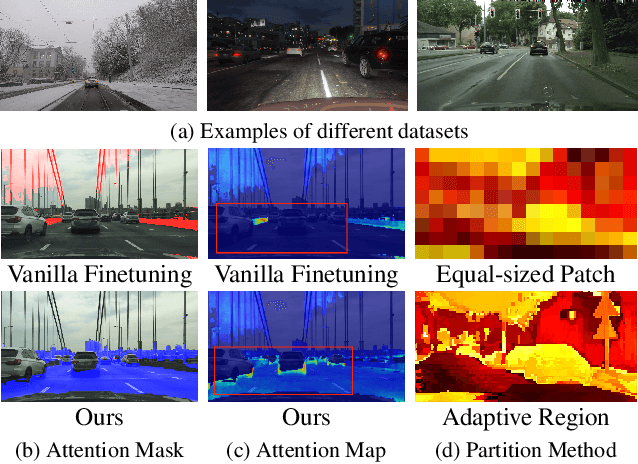
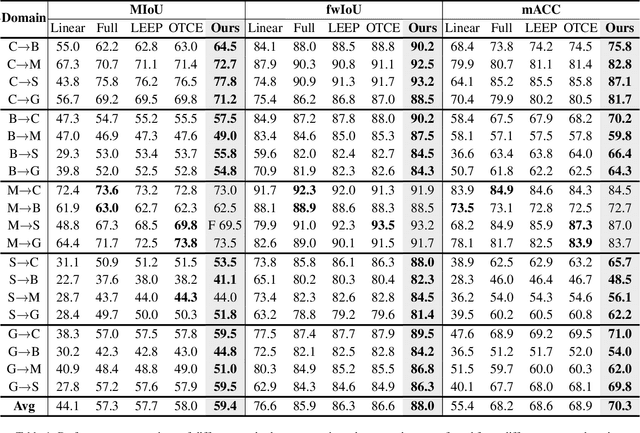
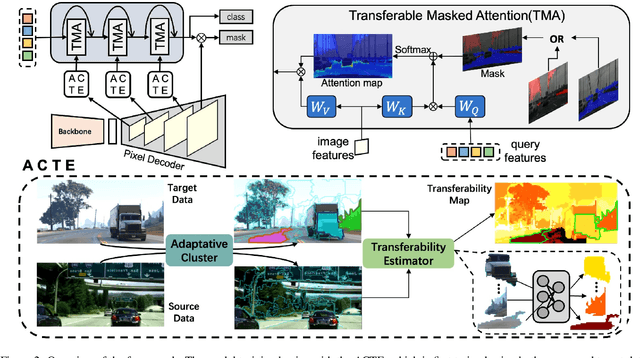

Abstract:Recent advances in Vision Transformers (ViTs) have set new benchmarks in semantic segmentation. However, when adapting pretrained ViTs to new target domains, significant performance degradation often occurs due to distribution shifts, resulting in suboptimal global attention. Since self-attention mechanisms are inherently data-driven, they may fail to effectively attend to key objects when source and target domains exhibit differences in texture, scale, or object co-occurrence patterns. While global and patch-level domain adaptation methods provide partial solutions, region-level adaptation with dynamically shaped regions is crucial due to spatial heterogeneity in transferability across different image areas. We present Transferable Mask Transformer (TMT), a novel region-level adaptation framework for semantic segmentation that aligns cross-domain representations through spatial transferability analysis. TMT consists of two key components: (1) An Adaptive Cluster-based Transferability Estimator (ACTE) that dynamically segments images into structurally and semantically coherent regions for localized transferability assessment, and (2) A Transferable Masked Attention (TMA) module that integrates region-specific transferability maps into ViTs' attention mechanisms, prioritizing adaptation in regions with low transferability and high semantic uncertainty. Comprehensive evaluations across 20 cross-domain pairs demonstrate TMT's superiority, achieving an average 2% MIoU improvement over vanilla fine-tuning and a 1.28% increase compared to state-of-the-art baselines. The source code will be publicly available.
PokerBench: Training Large Language Models to become Professional Poker Players
Jan 14, 2025Abstract:We introduce PokerBench - a benchmark for evaluating the poker-playing abilities of large language models (LLMs). As LLMs excel in traditional NLP tasks, their application to complex, strategic games like poker poses a new challenge. Poker, an incomplete information game, demands a multitude of skills such as mathematics, reasoning, planning, strategy, and a deep understanding of game theory and human psychology. This makes Poker the ideal next frontier for large language models. PokerBench consists of a comprehensive compilation of 11,000 most important scenarios, split between pre-flop and post-flop play, developed in collaboration with trained poker players. We evaluate prominent models including GPT-4, ChatGPT 3.5, and various Llama and Gemma series models, finding that all state-of-the-art LLMs underperform in playing optimal poker. However, after fine-tuning, these models show marked improvements. We validate PokerBench by having models with different scores compete with each other, demonstrating that higher scores on PokerBench lead to higher win rates in actual poker games. Through gameplay between our fine-tuned model and GPT-4, we also identify limitations of simple supervised fine-tuning for learning optimal playing strategy, suggesting the need for more advanced methodologies for effectively training language models to excel in games. PokerBench thus presents a unique benchmark for a quick and reliable evaluation of the poker-playing ability of LLMs as well as a comprehensive benchmark to study the progress of LLMs in complex game-playing scenarios. The dataset and code will be made available at: \url{https://github.com/pokerllm/pokerbench}.
CATCH: Channel-Aware multivariate Time Series Anomaly Detection via Frequency Patching
Oct 16, 2024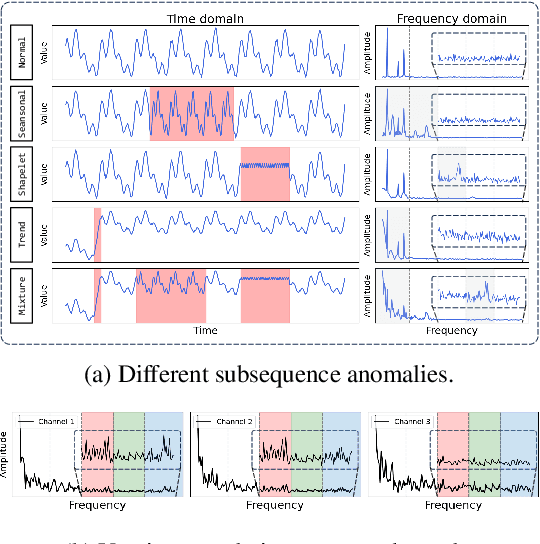

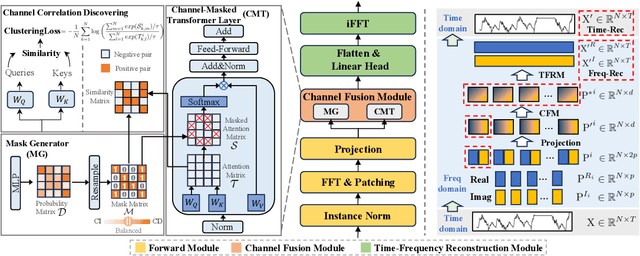

Abstract:Anomaly detection in multivariate time series is challenging as heterogeneous subsequence anomalies may occur. Reconstruction-based methods, which focus on learning nomral patterns in the frequency domain to detect diverse abnormal subsequences, achieve promising resutls, while still falling short on capturing fine-grained frequency characteristics and channel correlations. To contend with the limitations, we introduce CATCH, a framework based on frequency patching. We propose to patchify the frequency domain into frequency bands, which enhances its ability to capture fine-grained frequency characteristics. To perceive appropriate channel correlations, we propose a Channel Fusion Module (CFM), which features a patch-wise mask generator and a masked-attention mechanism. Driven by a bi-level multi-objective optimization algorithm, the CFM is encouraged to iteratively discover appropriate patch-wise channel correlations, and to cluster relevant channels while isolating adverse effects from irrelevant channels. Extensive experiments on 9 real-world datasets and 12 synthetic datasets demonstrate that CATCH achieves state-of-the-art performance.
AI-Generated Text Detection and Classification Based on BERT Deep Learning Algorithm
May 26, 2024Abstract:AI-generated text detection plays an increasingly important role in various fields. In this study, we developed an efficient AI-generated text detection model based on the BERT algorithm, which provides new ideas and methods for solving related problems. In the data preprocessing stage, a series of steps were taken to process the text, including operations such as converting to lowercase, word splitting, removing stop words, stemming extraction, removing digits, and eliminating redundant spaces, to ensure data quality and accuracy. By dividing the dataset into a training set and a test set in the ratio of 60% and 40%, and observing the changes in the accuracy and loss values during the training process, we found that the model performed well during the training process. The accuracy increases steadily from the initial 94.78% to 99.72%, while the loss value decreases from 0.261 to 0.021 and converges gradually, which indicates that the BERT model is able to detect AI-generated text with high accuracy and the prediction results are gradually approaching the real classification results. Further analysis of the results of the training and test sets reveals that in terms of loss value, the average loss of the training set is 0.0565, while the average loss of the test set is 0.0917, showing a slightly higher loss value. As for the accuracy, the average accuracy of the training set reaches 98.1%, while the average accuracy of the test set is 97.71%, which is not much different from each other, indicating that the model has good generalisation ability. In conclusion, the AI-generated text detection model based on the BERT algorithm proposed in this study shows high accuracy and stability in experiments, providing an effective solution for related fields.
AlphaMapleSAT: An MCTS-based Cube-and-Conquer SAT Solver for Hard Combinatorial Problems
Jan 24, 2024Abstract:This paper introduces AlphaMapleSAT, a novel Monte Carlo Tree Search (MCTS) based Cube-and-Conquer (CnC) SAT solving method aimed at efficiently solving challenging combinatorial problems. Despite the tremendous success of CnC solvers in solving a variety of hard combinatorial problems, the lookahead cubing techniques at the heart of CnC have not evolved much for many years. Part of the reason is the sheer difficulty of coming up with new cubing techniques that are both low-cost and effective in partitioning input formulas into sub-formulas, such that the overall runtime is minimized. Lookahead cubing techniques used by current state-of-the-art CnC solvers, such as March, keep their cubing costs low by constraining the search for the optimal splitting variables. By contrast, our key innovation is a deductively-driven MCTS-based lookahead cubing technique, that performs a deeper heuristic search to find effective cubes, while keeping the cubing cost low. We perform an extensive comparison of AlphaMapleSAT against the March CnC solver on challenging combinatorial problems such as the minimum Kochen-Specker and Ramsey problems. We also perform ablation studies to verify the efficacy of the MCTS heuristic search for the cubing problem. Results show up to 2.3x speedup in parallel (and up to 27x in sequential) elapsed real time.
Curvature-based Transformer for Molecular Property Prediction
Jul 25, 2023Abstract:The prediction of molecular properties is one of the most important and challenging tasks in the field of artificial intelligence-based drug design. Among the current mainstream methods, the most commonly used feature representation for training DNN models is based on SMILES and molecular graphs, although these methods are concise and effective, they also limit the ability to capture spatial information. In this work, we propose Curvature-based Transformer to improve the ability of Graph Transformer neural network models to extract structural information on molecular graph data by introducing Discretization of Ricci Curvature. To embed the curvature in the model, we add the curvature information of the graph as positional Encoding to the node features during the attention-score calculation. This method can introduce curvature information from graph data without changing the original network architecture, and it has the potential to be extended to other models. We performed experiments on chemical molecular datasets including PCQM4M-LST, MoleculeNet and compared with models such as Uni-Mol, Graphormer, and the results show that this method can achieve the state-of-the-art results. It is proved that the discretized Ricci curvature also reflects the structural and functional relationship while describing the local geometry of the graph molecular data.
 Add to Chrome
Add to Chrome Add to Firefox
Add to Firefox Add to Edge
Add to Edge